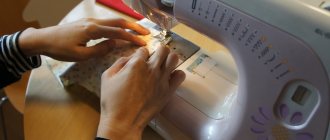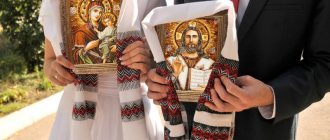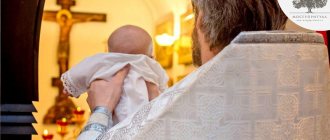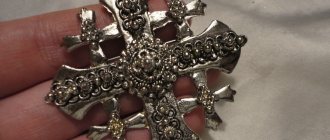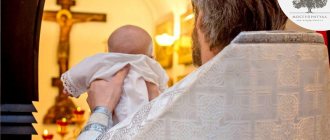History of origin
Church mallow, or popularly it has another name - prosphora , is baked in the form of a small round loaf of bread, it is used in church ceremonies and during donations and funerals. Prosvira in translation means “offering”. At the beginning of the first century, during the times of early Orthodoxy, people took bread and everything that was needed for services from home and brought it to the temple. The priest took all these products and entered their names into a special list, which was read out immediately after the prayer during the consecration of the gifts. Some gifts included bread and wine, which were used during the rite of Communion, and the remaining gifts were eaten by the monks at dinner or distributed to parishioners. Partially this tradition has reached our time. After the service at the church door, the priests give particles of the prosvira to the believers. After some time, the word “prosphora” began to be used to refer only to the bread that was used in the conduct of divine services. Such bread is baked only for this occasion.
Pieces of Lamb
Many people who believe in God go to church and pray. These are sacred rituals, using the right meal, keeping a fast. Small pieces of Lamb are cut out from a piece of prosphora. They are served in any churches during or after services. The meaning of the prosphora is similar to the antidora. Antidora means "communion". So prosphora is used for remission of sins and cleansing of the soul. People cannot take communion every day, but every person can afford to eat a piece of prosphora. This is the symbol of communion.
It is necessary to take the prosphora with your hands crossed crosswise. Then kiss the hand of the priest who gave the prosphora.
What to do with dried prosphora?
Many people do not know how to properly treat sacred bread brought from church or made with their own hands. Like any other baked product, prosphora becomes dry after some time and many people don’t know what to do with it. It's simple: you need to soak the bread in holy water and eat it. It is important to know what to do with the prosphora brought from the church, so it must be stored in a holy corner next to the icons and holy water. For long-term storage, it is recommended to place the bread in a paper bag.
What to do if the prosphora becomes moldy? Answer from priest Anthony Skrynnikov
A prosphora was given in the church, they simply put it in a bag and tied it, and then simply forgot about it. What to do next? This situation describes a careless attitude towards the shrine. After all, prosphora is distributed to people to cleanse the soul. A person cannot take communion every day, but he can eat the sacred prosphora. She cleanses the soul and conducts confession of sins. When the prosphora becomes moldy, it can be dipped in the river. It can also be buried in the ground, but away from places where people walk.
It is best to ask temple servants about what to do with moldy prosphora. The priests will definitely give an answer.
Artos
A special place among the works of Orthodox prosphora is occupied by artos
- leavened bread, blessed on Easter. This bread stands in the church in front of the iconostasis throughout Bright Week; it is carried during Easter religious processions. Artos, as it were, absorbs the grace of the main Christian holiday. On Bright Saturday after the Liturgy, it is crushed and distributed to the faithful for reverent consumption. According to tradition, the image of the Resurrection of Christ or the image of a cross with the inscription “Christ is Risen” is applied to the artos.
The symbolic meaning of artos is as follows. After the Resurrection of Christ, the apostles lived, believing in the constant presence of the Divine Teacher in their lives. When gathering for meals, they left one place unoccupied - for the Lord Jesus Christ, and put bread in this place, and then divided it among themselves as a shrine. So we must always remember the invisible presence of God.
Church mallow recipe
To bake church bread, you need to take one and a half kilograms of your type of flour. To knead the dough, you need to pour a third of the flour into a deep bowl and pour in the agisma. After stirring just a little, boiling water is poured into the dough. This action gives the strength and sweetness of the mallow. After a little time, when the dough has cooled, add a little salt diluted in holy water and add twenty-five grams of yeast. Then this whole mixture is mixed and left for about half an hour. When the dough has risen, add the rest of the flour to it and mix again. Then set aside again for thirty minutes so that the dough can rise again. After half an hour, when the dough is ready and risen, it must be rolled out, diligently sprinkled with flour. Using molds, roll out circles: the upper part is smaller, the lower part is larger. Then such mugs are covered with a dampened cloth, covered with a dry cloth on top, and again set aside for thirty minutes. Then a seal is placed on the top, and the upper part is attached to the lower part, while the parts are moistened with warm agisma. The prepared mallow must be pierced on the sides with a needle, and then it is placed on a baking sheet and placed in the oven, where it is baked for about fifteen to twenty minutes. The baked prosphora is placed on the table and covered, first a dry cloth is laid, then a damp cloth and then a dry cloth again, and they are left to rest for an hour. Then they are put into special boxes. And the recipe for making prosphora also contains a certain essence. Flour and water represent the human body, while yeast and agisma symbolize the human soul. All these ingredients are inextricably linked, but in turn, a separate element symbolizes something of its own. Agisma means the Lord's mercy sent to people. Yeast carries within itself the sign of the Holy Spirit, who, with his divine ability, bestows life.
Prosphora - recipe
Sacred bread can be prepared at home using an old recipe. It is important to know how prosphora is baked, as there are several features that should be taken into account.
Ingredients:
- finely ground premium flour – 1.2 kg;
- Holy water;
- yeast – 25 g.
Preparation:
- Pour some holy water into the container, and then pour in about 400 g of flour. Add boiling water and stir until you get a mass like semolina porridge.
- When everything has cooled down, add a little salt and yeast. Stir and leave to rise. Then add the remaining flour and mix well.
- Leave for another 30 minutes, and then transfer the dough to the table and roll out the layer. The bottom layer needs a thickness of 18-20 mm, and the top layer 11-12 mm. Cover with oilcloth and leave for another 10 minutes.
- It is necessary to cut the layer into circles, taking into account that the lower part should be larger than the upper. Cover the lower halves with a towel and oilcloth and leave for half an hour. It is important not to let the dough dry out.
- If you are interested in how to bake prosphora at home, then it is important to know that the baking sheet must be greased with a thin layer of natural wax, which is a component of solar energy. Place a stamp of the appropriate size on the top.
- Lubricate the bottom and connect it to the top. Prick both halves with a needle to remove excess air, which will prevent voids from forming.
- The oven should be heated to 200-250 degrees. Bake until done, which is 15-20 minutes.
- The finished bread should be covered with several layers: a dry cloth, a wet one, then a dry one again and a blanket. Leave the prosphora in this state for an hour.
What is antidor
At the end of the Liturgy, the antidor is distributed to the worshipers - small parts of the prosphora from which the Holy Lamb was taken out at the proskomedia. The Greek word antidor comes from the Greek words anti - instead of and di oron - gift, that is, the exact translation of this word is instead of gift.
“Antidorus,” says Saint Simeon of Thessalonica, “is sacred bread that was offered as an offering and the middle of which was taken out and used for sacred rites; this bread, as sealed with a copy and having received divine words, is taught instead of terrible Gifts, that is, the Mysteries, to those who have not partaken of them.”
The custom of distributing the antidoron apparently arose at a time when the ancient tradition of giving communion to all those present at the Liturgy disappeared. In the ancient Church, everyone present at the Liturgy considered it an obligation to receive communion. Even those who could not attend the Divine Supper considered the deprivation of the Holy Gifts too difficult for themselves. That is why the deacons distributed gifts to the sick, those imprisoned, and those under guard. Those who went on the road took gifts with them.
But subsequently such zeal weakened, as did the love for the Lord Jesus Christ. Many stopped going to the Divine Liturgy altogether, and of those who came, the majority did not take part in the Divine Supper. That is why, instead of the Holy Gifts, they began to distribute those loaves that remained from the bloodless sacrifice. At first it was called a blessing (in Greek - eulogia), because these loaves, although they were not consecrated as Holy Gifts by the invocation of the Holy Spirit, were blessed and sanctified by the fact that they were among the offerings. Since there was a confusion of concepts here (the Divine Supper itself was called a blessing - eulogia), the distribution of bread began to be called antidorea, antidor, which means retribution, reward.
Why does it get moldy?
Why the prosphora became moldy will remain a mystery to any person. After all, this is a sacred product that simply cannot be spoiled. But, unfortunately, this can happen. According to the experience of many people, there are various methods to store this product. The prosphora must be cut into small pieces and placed in a linen bag. They will dry out and turn into crackers. In this form they can be eaten gradually. If you put them in a plastic bag, you cannot close them and leave them without air. And in a dried state, such pieces can be stored for at least several years. If the prosphora is moldy, what does it mean? Mold may appear on sacred bread due to the fact that there is some moisture inside it, and this is the best environment for bacteria to accumulate.
Prosphora - how to use?
There are several rules regarding how to properly eat sacred bread. This should be done in the morning on an empty stomach and to begin with, it is recommended to spread a clean napkin on the table and place bread and water on it. When figuring out how to eat prosphora at home, it is worth mentioning that before eating it, a prayer intended for this occasion must be said. They eat bread over a plate so that crumbs do not fall on the floor. It is important to note that prosphora should not be used in cemeteries and crumble on graves.
How to cut prosphora correctly?
In temples, a special knife designed for this purpose is used to cut the sacred bread. It is called a spear and is a flat knife shaped like the tip of a spear. It cannot be stored with other cutlery. Many people are interested in whether it is possible to cut prosphora with a knife, but most clergy argue that ordinary kitchen utensils should not be used.
Prayer for accepting prosphora and holy water
It is believed that when a believer reads a prayer before eating prosphora and drinking holy water, this leads to the sanctification of the body and spirit, the illumination of thoughts, and this will also protect him from evil spirits. Parts of the prosphora are taken out at the end of the liturgy and believers must fold their palms into a cross, with the right hand covering the left. After handing over the prosphora, you must kiss the hand of the clergyman. Having brought the sacred bread home, place it on a clean napkin and before eating it, be sure to read a prayer before accepting the prosphora and holy water.
How to properly use prosphora and its unique properties
Prosphora is bread intended for the sacrament of the Eucharist, i.e. Communion, however, not many people know about all the unique properties of this bread. We'll talk about this in this article.
Prosphora is a round small bread consisting of two parts (a symbol of the dual nature of Christ - Divine and human).
It is necessary to store the prosphora near the icons, preferably in a clean white cotton bag.
The prosphora is eaten on an empty stomach in the morning and washed down with holy water.
Prosphora has a unique and amazing healing power for many diseases, and when combined with holy water, these properties increase tens or even hundreds of times. That is why the Church recommends consuming prosphora, washing it down with holy water.
How to use it correctly
If you suddenly feel any ailment or feel that you are getting sick, immediately cut off a small piece of prosphora and, with prayer and reverence, taste the holy bread and wash it down with a small sip of holy water. Just don’t drink holy water as if you were thirsty after the summer heat, just take a sip or two and nothing more. This will be enough to make you feel relieved.
If the prosphora has turned into what is called a “stone” over time, then it should be soaked. This bread, as a rule, does not spoil.
Do not under any circumstances throw away the prosphora or give it to pets for food. This is a shrine, holy bread, and you need to treat it accordingly.
Good Friday and prosphora. Peculiarities of consumption of sacred bread during Lent
Good Friday is a period of strict fasting that requires increased attention. According to church laws, you cannot consume any drinks or food on this day. You cannot eat bread, eggs and many other foods. The exception in this case is prosphora and holy water. You can only eat bread and drink fresh sacred water. Therefore, prosphora is perfect for eating. You can and should eat it and you shouldn’t refuse it. But it is best to do this once a day, namely early in the morning on Good Friday.
I'll go to the prosphora...
From the conversations it became clear that no specific education is needed to become a prosphora teacher. And even if you graduate from the Institute of Food Technology, this knowledge is unlikely to be useful in practice.
They get into prosphora bags in different ways. Father David, for example, served as a sexton, and when the prosphora was being built, he himself proposed his candidacy, taking responsibility for the future work. Friends and acquaintances came. As a result, a friendly, well-coordinated team of 12 people emerged.
About eating prosphora, antidor and artos
The prosphora, which is given after the end of the Liturgy, is sacred and is reverently eaten by the believer before taking any food.
According to the rules of the Church, the antidoron must be eaten in church, on an empty stomach and with reverence, because this is holy bread, bread from the altar of God, part of the offerings to the altar of Christ, from which it receives heavenly sanctification.
Particles of artos received in the temple are reverently kept by believers as a spiritual cure for illnesses and infirmities. Artos is used in special cases, for example, in illness, and always with the words “Christ is risen!”
The prosphora and artos are kept in the holy corner near the icons. Spoiled prosphora and artos should be burned yourself (or taken to church for this) or floated down the river with clean water.
Responsibility
It is strictly forbidden to allow the prosphora to become moldy. If you took it from church, be sure to eat it and not leave it in the closet. What to do in this case has already been described in this article above. Every person must understand the responsibility and believe that this is a sacred product. It should not be given to animals or left in a bag. Most believers understand that prosphora is used together with prayer. A person reads a prayer, takes a piece of this bread and drinks it with sacred water. This leads to insight into thoughts, revival of soul and body. A person experiences relief if he needed to confess or receive communion.
Prosphora must be consumed on an empty stomach. There is an opinion that during the menstrual cycle a woman cannot go to church, stand at services, or eat sacred foods. Because on such days she is considered an unclean person.
What to do if the prosphora becomes moldy? Answer from priest Anthony Skrynnikov
A prosphora was given in the church, they simply put it in a bag and tied it, and then simply forgot about it. What to do next? This situation describes a careless attitude towards the shrine. After all, prosphora is distributed to people to cleanse the soul. A person cannot take communion every day, but he can eat the sacred prosphora. She cleanses the soul and conducts confession of sins. When the prosphora becomes moldy, it can be dipped in the river. It can also be buried in the ground, but away from places where people walk.
It is best to ask temple servants about what to do with moldy prosphora. The priests will definitely give an answer.
How to properly store and handle prosphora
Prosphora is a sacred thing, spiritual food, it is called “heavenly bread.” Therefore, you need to treat her with respect. Prosphora must be stored dried near icons or in a place for storing shrines, so that it cannot be confused with ordinary bread (fresh prosphora is best stored in the freezer). For long-term storage, it is better to cut the prosphora into small pieces and dry it. Then put it in a special box or bag.
Only Orthodox Christians should eat prosphora, carefully and reverently, so that the crumbs do not fall on the floor. Prosphora should not be given to animals and birds.
What are the prohibitions?
Deacon Pavel Serzhantov writes on the website “” that prosphora is not so much a ritual food as a spiritual one. According to the priest, only Orthodox Christians can eat this bread. Therefore, according to the deacon, feeding prosphora to animals and birds, of course, should not be done.
Read also: What is sports betting?
Priest Andrei Chizhenko on the “Orthodox Life” portal warns believers that prosphora must be consumed carefully, not littered, and not scatter bread crumbs everywhere. Before eating, it is best to place the prosphora on a napkin previously spread on the table. This way, particles of consecrated bread will not even accidentally fall on the floor.
You should also not eat prosphora in a cemetery, much less crumble it on the graves of the deceased. Anatoly Badanov on the website “I Breathe Orthodoxy” points out the fact that the dead do not need food, but exclusively the prayers of their family and friends.
Forms of church bread
Church mallow comes in several forms. There are five types of them based on the seals for the prosphora:
- Agnic. This product is large in size with a cross. A lamb is cut out of it with a special knife - bread, which has the shape of a cube. During the liturgy, the lamb becomes the true body of Christ. The part that was not used is called antidor. After the service it is distributed to believers .
- Mother of God. On such a loaf there is a stamp “Mary” or the image of the Mother of God. When proskomedia passes, a triangle-shaped part is removed from the upper part. It is placed on a special dish next to the lamb.
- Nine-day. Such a mallow is dedicated to all the saints, and during the service nine parts are taken out of it.
- Zazdravnaya. Two parts are taken out of such baked goods for everyone who participates in the liturgy.
- Funeral. From this they take only one part from above for all the deceased believers.
In addition to these species, there are several more special species. This is artos - a loaf of bread that is blessed on Easter night. At this time, the clergyman asks God for blessings and help in healing ailments. This type of prosphora is located opposite the Royal Doors throughout Bright Week. On Saturday, it is divided into small parts and distributed to believing parishioners. Artos is a symbol of the resurrection of Jesus Christ and should remind of his presence on earth.
Eating Church Bread
There are several rules about prosphora. All believers need to know how to use it. First of all, this is done on an empty stomach in the morning. It is recommended to first spread a clean napkin on the table and place bread and some water on it. When eating bread at home, before eating it, you should read a prayer . It is necessary to eat the bread over a plate and make sure that the crumbs do not fall on the floor. They do not use mallow in cemeteries either. You also can't paint it there.
To cut the sacred bread, temples use a knife specially designed for this purpose. It's called a copy. It is a knife that has a spear-shaped . This knife should not be stored next to other cutlery. The clergy do not recommend cutting prosphora with ordinary kitchen cutlery.
It is generally accepted that reading a prayer before eating sacred bread and drinking holy water leads to the sanctification of the body and spirit and helps protect against evil spirits. The prosphora, divided into parts, is taken out at the end of the service, at which time parishioners should fold their palms into a cross. In this case, the right palm should cover the left. After handing over the bread, you should kiss the priest's hand. After it is brought home, it should be placed on a clean napkin. Before drinking holy water with mallow, you need to read a prayer .
If the prosphora has become moldy or spoiled
Sometimes sacred bread brought home can dry out or become moldy. Believers need to know what to do with it and how to act correctly. You can deal with dried bread very simply - you should soak it, using holy water, and eat it. This church treat is kept in the corner where the icons stand. For long-term storage, it is better to put it in a paper bag.
If the prosphora becomes moldy, what should you do? This is primarily considered the result of careless handling of the shrine. Therefore, the clergy consider this a sin and recommend confession. The moldy loaf is dealt with in the same way as other sacred objects that must be destroyed. You can do this as follows:
- bury in a place where people do not walk;
- float down the river. In this case, it is necessary to ensure that it does not stick to the shore (you can crush it or tie it to a stone);
- if the loaf has spoiled, you can take it to church, where it will be burned;
- The clergy are allowed to crush the bread and give it to the birds, but throwing the crumbs on the ground is prohibited; it is recommended to put them on a board. Giving prosphora to animals is prohibited.
Pieces of Lamb
Many people who believe in God go to church and pray. These are sacred rituals, using the right meal, keeping a fast. Small pieces of Lamb are cut out from a piece of prosphora. They are served in any churches during or after services. The meaning of the prosphora is similar to the antidora. Antidora means "communion". So prosphora is used for remission of sins and cleansing of the soul. People cannot take communion every day, but every person can afford to eat a piece of prosphora. This is the symbol of communion.
It is necessary to take the prosphora with your hands crossed crosswise. Then kiss the hand of the priest who gave the prosphora.
Prosphora - what is it. What to do with it, why, when to eat it
The dough for such bread is kneaded with holy water, which means that all the bread becomes sacred. Thus, a person, consuming such bread, himself is sanctified.
Prosphora should be stored in a separate form, but if this is not possible at home, then there are special bags for storing such bread. It doesn’t matter where the bread will be stored, in a church or at home, the main thing is to place it next to the icons.
As we have already found out, such bread should be consumed only on an empty stomach. It should be noted that women during menstruation are prohibited not only from appearing in church, but also from eating sacred bread.
It is believed that any shedding of blood in the temple is unacceptable. Even if a person has any bleeding wound, he is also prohibited from going to church.
Holy bread should also not be consumed on Good Friday.
In addition to all of the above, there are other rules for using such a product:
✔ Do not mix prosphora with other products. The point is that you cannot eat other dishes, even lean ones, at the same time as this bread. Bread should be consumed separately, and only on an empty stomach.
✔ Before use, you must read a prayer. Only after this can you begin to eat the sacred bread.
✔ After you have brought bread from church, you need to lay a clean tablecloth on the table , on which you need to put the prosphora. During consumption, you can burn the bread with water, but this water must be consecrated;
✔ You should eat bread carefully so that not a single crumb falls on the floor.
If the bread is consumed after the service, and is usually washed down with warmth - warm water diluted with a small amount of wine. You can replace wine with jam, which will make the drink sweeter.
After the service, people are given a slice of prosphora, which must be washed down with warmth. It is important here that the sacred food is not in any way regurgitated as a result of unexpected coughing or spitting.
That is, if you came to church by car, then it is better for you to refrain from drinking wine. In this case, you can simply ask the church ministers for simple blessed water. But, under no circumstances should you spit out the wine you were supposed to drink.
Pieces of Lamb
Many people who believe in God go to church and pray. These are sacred rituals, using the right meal, keeping a fast. Small pieces of Lamb are cut out from a piece of prosphora. They are served in any churches during or after services. The meaning of the prosphora is similar to the antidora. Antidora means "communion". So prosphora is used for remission of sins and cleansing of the soul. People cannot take communion every day, but every person can afford to eat a piece of prosphora. This is the symbol of communion.
It is necessary to take the prosphora with your hands crossed crosswise. Then kiss the hand of the priest who gave the prosphora.

